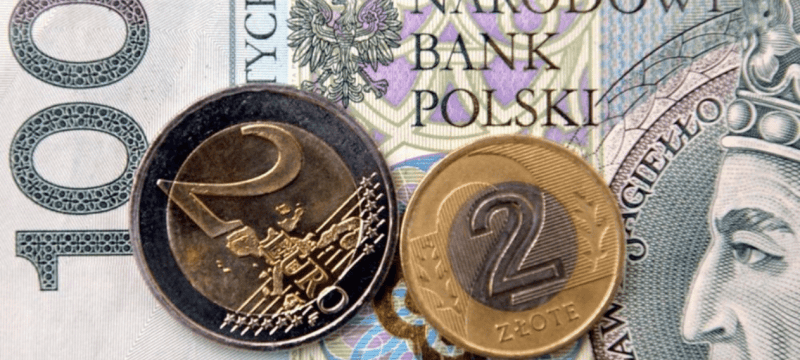This year, the Hungarian forint is up 10% against the US dollar, with the Czech koruna, Polish zloty, and Romanian leu close behind. What is behind the recent surge in Eastern European currencies, and how long will it last?
The Czech koruna achieved a 14-year high earlier this year, and the Hungarian forint set a 10-month high, boosted by high interest rates, dropping energy prices, and a strong euro. Despite a drop in economic activity, the two currencies — later joined by the Polish zloty and Romanian leu — have risen.
Observers are wondering how this happened and how long it will persist.
Except for Slovakia, the currencies of Central and Eastern Europe (CEE) have profited most from a high interest rate differential known as the real interest rate, which is derived by subtracting the rate of inflation from the nominal interest rate. In comparison to ECB and US Fed rates, CEE currencies today appear to be more appealing.
Except for Slovakia, the currencies of Central and Eastern Europe (CEE) have profited most from a high interest rate differential known as the real interest rate, which is derived by subtracting the rate of inflation from the nominal interest rate. In comparison to ECB and US Fed rates, CEE currencies today appear to be more appealing.
Why are CEE currencies doing well?
According to Piotr Arak, head of the Polish Economic Institute (PIE), rising exports, cheaper energy, and capital inflows due to increased interest rates “result in stable currencies.”
“During recent quarters, there has been a noticeable improvement in current account balances and exports as the region’s countries continue to grow, while the decrease in commodity prices has led to lower import burdens,” Arak told DW.
Zloty experiences ‘golden spring’
In Poland, the central bank kept its main interest rate at 6.75% on May 10, the same level as in September, while inflation declined to 14.7% in April from 16.1% in March.
In an interview with the weekly Gazeta Polska, Adam Glapinski, governor of the National Bank of Poland, predicted that inflation will decrease to single digits by the beginning of September. If inflation continues to fall, interest rates could be reduced towards the end of the year.
However, according to ING bank’s monetary policy analyst Rafal Benecki, the March data from the Polish economy was not “a pretty picture” in this regard, indicating that the current high interest rates are taking some heat off the economy.
Core inflation remained basically steady, implying that businesses are passing on higher costs to customers, and that disinflation is primarily attributable to the easing of the energy shock and decreasing food price pressure.
ING anticipates the central bank to hold policy rates steady by the end of this year, with reduction beginning as early as 2024, implying that the short-term opportunity for further zloty advances may have been “largely exhausted,” as Benecki stated in a client note.
According to the ING analyst, commodity price drops, particularly natural gas, influenced the direction of reduced price dynamics. So were the government’s expenditure plans before of the general election in November. “Pre-election fiscal promises remain a major risk,” stated Benecki.
Forint, koruna and leu’s fate hinges on risk appetite
Since the beginning of the year, the Hungarian forint has gained 6.6% against the euro and 9.3% against the US dollar. Since October, the National Bank of Hungary (NBH) has kept the interest rate at 13% constant.
Nonetheless, because the country’s economy has been in a technical recession for three quarters, most economists anticipate Hungary could see its first interest rate drop before the end of the year.
According to ING, the economy will recover in the second quarter, with full-year GDP growth of 0.7%. Despite the slow expansion, the trade balance has benefited from decreasing energy prices, which have also boosted the national currency.
Meanwhile, in Romania, the central bank held the benchmark interest rate at 7% for the second month in a row in April. Economists predict that interests will remain unchanged in 2023. In comparison to its Central European counterparts, the Romanian economy has demonstrated significant resilience.
In Romania, as in the rest of the region, inflation was strong, with the central bank forecasting a 7% increase by December. As a result, rate reduction will “likely not happen” until inflation matches interest rate levels, according to a recent report.
The Czech koruna has stayed strong in 2023, despite falling from a 15-year high against the euro in mid-April. Czechia’s GDP increased by 0.1% quarter on quarter, lifting the country out of recession, with trade driving the rise.
What are the threats?
According to Piotr Arak of PIE, a large part of the value development of CEE currencies is dependent on inflation paths, which are likely to remain high for a longer period of time than in the eurozone.
“This could lead to a decrease in purchasing power.” Furthermore, a slowing economy may result in fewer foreign investment and increased government deficits. “Both would be negative,” he remarked.
As a result, PIE assessments predict that the current strengthening of the zloty and other CEE currencies will be short-lived. “Our long-term forecasts show that these currencies will most likely depreciate.” However, there may be differences between countries.”
The risk of a US recession, which would also put CEE currencies on the back foot, is currently hovering above many national economic forecasts. Similarly, anxiety regarding the global financial system’s health remains high following a number of recent crises. Any stress there could lead to a decrease in capital inflows, particularly in emerging markets such as the CEE countries.





